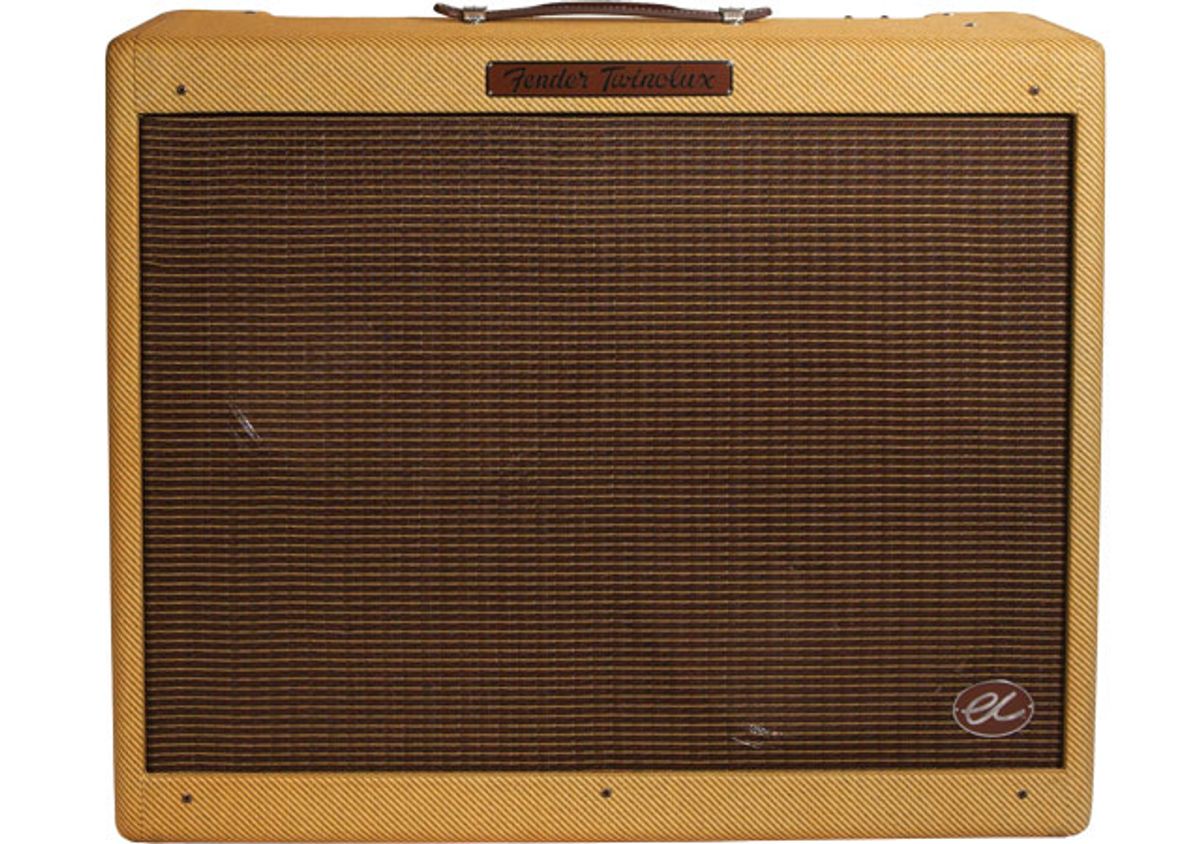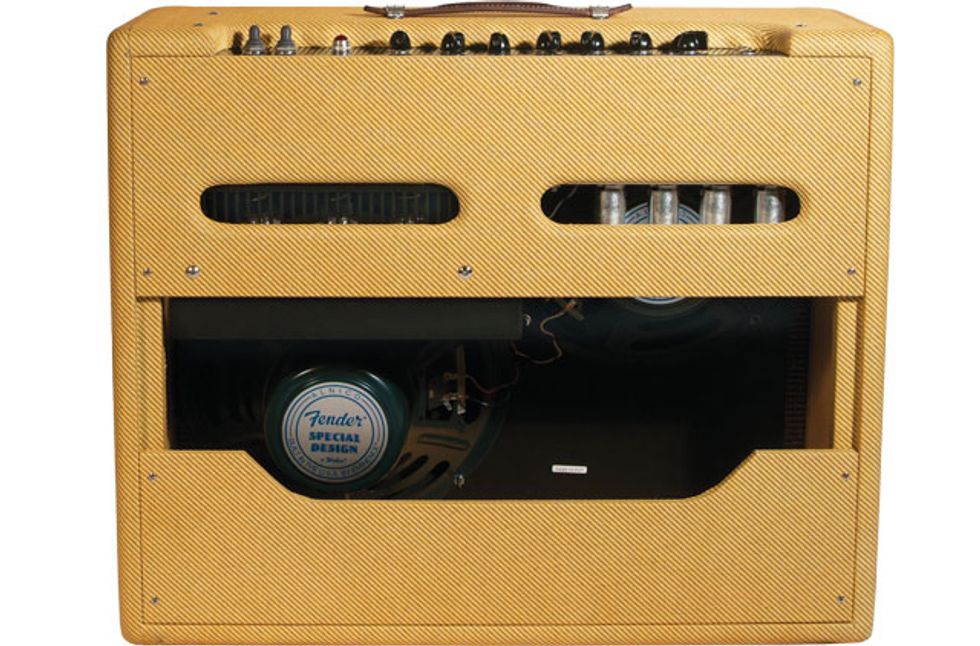
What’s remarkable about the EC Twinolux is how, like so many great Fender amps, it can be a beautiful blank slate for anything.
Fender’s relationship with Eric Clapton has been fruitful beyond the clout that comes with comfy star associations. As anyone who has played a good Clapton signature Stratocaster can attest, the dividends are musical too. Until this point, however, Fender’s relationship with Clapton, or any of their high-profile player endorsees, has been about guitars—an odd situation given that Fender’s amps nearly rival the company’s 6-strings in terms of historical importance.
That all changed this year with the introduction of three Eric Clapton signature amps, the EC Vibro-Champ, the EC Tremolux, and the EC Twinolux reviewed here. None of these three amps are radical reinventions, and each is based to some extent on a Fender classic. But Clapton’s collaboration with the Fender design team, which resulted in features like tremolo and power attenuation, makes each of them a unique amplifier.
What’s remarkable about the EC Twinolux is how, like so many great Fender amps, it can be a beautiful blank slate for anything. And while it took the help of a pedal or two to cop tones from say, Slowhand’s more extreme Cream moves, the Twinolux is an able and willing running mate for ventures into territory ranging from crunch to near-pure clarity, as well as sounds that have nothing to do with Clapton’s repertoire at all.
Tricky Twin
Just as the EC Vibro-Champ is a variant
of the ’57 Champ, and the EC Tremolux
(reviewed online at premierguitar.com) is a
variant of the ’57 Deluxe, the EC Twinolux
is based on the ’57 Twin—a reissue of the
40-watt tweed Twin that Clapton has used
onstage since Cream’s 2005 reunion. In
many ways, the original narrow-panel Twin
was the template for most of the famous
mid-to-high-power Fenders that would
follow—6L6 power tubes, 12AX7 preamp
tubes, 12" Jensen speakers, and a clean but
bellowing voice that gave you something a
little extra when you cranked it up.
In terms of specifications and appearance, the Twinolux is a very close relative to that first narrow-panel Twin. The circuit is based on the 5E8-A schematic that’s the foundation of the narrow-panel original. The two 6L6GE power tubes help conjure 40 watts of firepower and four 12AX7s help power the preamp section. Like the original Twin, the Twinolux has dual 5U4GB rectifier tubes. A peek into the open-backed cabinet reveals two 40-watt Weber-designed alnico speakers (built by Eminence), and transformers built by Mercury Magnetics. The control set is straightforward, if a little less than totally logical. A Presence knob is all the way to the right and is separated from the rest of the tone controls by the Speed and Depth controls for the tremolo.
At its core, the Twinolux may not differ too much from the ’57 Twin. But the obvious differences are significant. First, there’s an output-tube bias tremolo circuit. More importantly though—at least in terms of the Twinolux’s overall versatility—there’s a 3-position attenuation switch that not only cuts the power down to apartment-friendly levels, but will cut a speaker out of the mix too, for more controlled output.
Physically, the Twinolux is a thing of beauty. The finger-jointed pine and lacquered-tweed cabinet is the embodiment of Fender minimalist elegance. And it makes the ugliest guitar look about 50 times cooler when parked against the Twinolux.

Sweet and Simple
There’s really no way to test the EC Twinolux
without a Stratocaster on hand, but I also
used a humbucker-equipped Telecaster
Custom, a Jaguar with Seymour Duncan
Hot pickups, and a Rickenbacker 12-string
to probe the Twinolux’s range of voices. And
one of the sweetest aspects of the Twinolux is
how agreeable it sounded with each guitar.
Oddly, it was the Stratocaster that demanded the most patience and tone tweaking. Working with the Twinolux’s volume at about 30 percent and the tone controls at noon, the bridge pickup on the Stratocaster was pretty trebly and even a little thin for 1st-position chords. It’s not a bad setup for playing mellow blues shuffles, Prince-style funk vamps, or Slowhand’s own patented “Lay Down Sally” muted-and-popping rhythm style. But to really make a Stratocaster work for more rocking and bluesy stuff, you have to kick up the Bass and bring the Treble down to about 25 percent. What you lose in high-end definition, you can add with a nudge of the Presence control, which can also lend a little more body and color to the amp’s essentially compressed voice.
The hotter output and rounder, almost P-90-like qualities of the Jaguar’s pickups were a better fit. And with an overdrive pedal in between the Jag and Twinolux, I got a clearer picture of how accommodating this amp really is—the Twinolux does a remarkable job of communicating the personality of guitar and effects, and it really seemed to love the kick in the pants it received from my battered Tube Screamer without sacrificing an ounce of its own flavor.
The most natural sounding pairing for the Twinolux was the humbucker-equipped Telecaster, which seems to tame the amp’s treblier tendencies and works well with its natural compression. The neck humbucker in particular is especially well suited to the amp’s wide-open, high-volume settings. Here again, the Twinolux benefits from conservative use of treble and generously applied bass. But exploring higher volumes with a wide-open humbucker seems to enliven every last shade in the Twinolux’s tone palette. The amp will stay sparklingly clean (and plenty loud for a rockin’ drums/bass/keyboard combo) up to about 30 to 40 percent of full volume. After that, the Twinolux doesn’t really get louder, just more compressed and overdriven. But each increase up to full blast adds another hue to the amp’s crunchy and singing voice, and a little finesse with your touch will open up a world of dynamics. This is where the presence control comes in handy too, and you can lend more harmonic balance and space to a very muscular basic tone with a boost in the Presence.
In this environment, the Twinolux can evoke everything from one of Joe Walsh’s exploding James Gang tweeds to a JTM-45. And most importantly for Clapton fans, this is where the woman tone lives on the Twinolux—a beautiful, round and husky violin tone that will transport you straight to the domain of Ulysses—or beyond if you put a Tone Bender or Fuzz Face out in front and roll off your guitar tone. Even at its most aggressive settings, this amp still loves fuzz and overdrive.
The attenuation options on the Twinolux are a smart touch. Back at home, I used the single-speaker setting through the night for a few 12-string-based projects, and neither a cut in power nor speaker count affected the Twinolux’s ability to convey the 12-string’s harmonic complexity. In fact, I might have been more inclined to use the attenuated output in a recording environment for rhythm work and arpeggios, given its warmth and overall civility.

The tremolo is effective for a subtle wash and lending movement to simple rhythm work—particularly when working that dry, spanky Stratocaster tone zone. But though Fender says the tremolo is throbbier than their typical ’60s-style circuit, I didn’t find it quite as swampy as the circuits in my reissue Vibroverb or my vintage Tremolux, even at the most aggressive intensity settings.
The Verdict
Apart from the obvious high-gain applications,
it’s hard to imagine a musical setting in
which the EC Twinolux wouldn’t excel. The
burly, bassy end of its tone spectrum and
exceptional touch sensitivity make it a great
jazz amp. Roll up the Treble a touch and
kick on the treble pickup of your Telecaster
and you’ll be kicking down barn doors like
Don Rich. And needless to say, Slowhand
himself must be proud at how readily this
amp can move from round and wooly
Cream-era tones to 461 Ocean Boulevard
without a hitch.
There are a few drawbacks. This amp will sound too brittle and trebly for a lot of Stratocaster players who like a meatier kind of chiminess. And the lack of reverb when you do get that ideal Fender tone locked in can be just short of excruciating. The Twinolux isn’t cheap either, at almost three grand out the door. But given the Twinolux’s range and beautiful build quality, this may be the only amp you need for 80 percent of the music you make, and given that math, it may be worth the investment. Considering everything this amp can do, it might just be a perfect launching pad for exploration of your own musical voice—even if you’ve never heard an Eric Clapton record in your life.
Buy if...
you’re on the hunt for a perfect marriage of Fender 6L6 versatility and a wide range of Slowhand tones.Skip if...
you need Marshall-style gain on top of your clean, biting tones.Rating...


